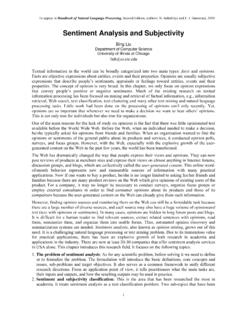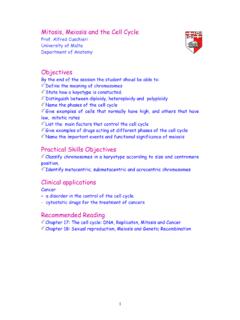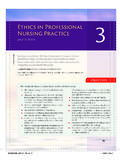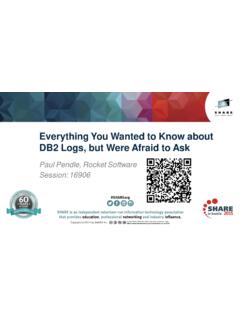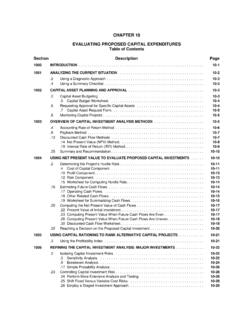Transcription of Checkpointing & Rollback Recovery
1 Checkpointing & Rollback Recovery chapter 13 Anh Huy Bui Jason Wiggs Hyun Seok Roh 1 Introduction Rollback Recovery protocols restore the system back to a consistent state after a failure achieve fault tolerance by periodically saving the state of a process during the failure-free execution treats a distributed system application as a collection of processes that communicate over a network Checkpoints the saved states of a process Why is Rollback Recovery of distributed systems complicated? messages induce inter-process dependencies during failure-free operation Rollback propagation the dependencies may force some of the processes that did not fail to roll back This phenomenon is called domino effect 2 Introduction If each process takes its checkpoints independently.
2 Then the system can not avoid the domino effect this scheme is called independent or uncoordinated Checkpointing Techniques that avoid domino effect Coordinated Checkpointing Rollback Recovery processes coordinate their checkpoints to form a system-wide consistent state Communication-induced Checkpointing Rollback Recovery forces each process to take checkpoints based on information piggybacked on the application Log-based Rollback Recovery combines Checkpointing with logging of non-deterministic events relies on piecewise deterministic (PWD) assumption 3 4 A local checkpoint All processes save their local states at certain instants of time A local check point is a snapshot of the state of the process at a given instance Assumption A process stores all local checkpoints on the stable storage A process is able to roll back to any of its existing local checkpoints , The kth local checkpoint at process ,0 A process takes a checkpoint .
3 0 before it starts execution Consistent states A global state of a distributed system a collection of the individual states of all participating processes and the states of the communication channels Consistent global state a global state that may occur during a failure-free execution of distribution of distributed computation if a process s state reflects a message receipt, then the state of the corresponding sender must reflect the sending of the message A global checkpoint a set of local checkpoints, one from each process A consistent global checkpoint a global checkpoint such that no message is sent by a process after taking its local point that is received by another process before taking its checkpoint 5 Consistent states - examples 6 Interactions with outside world A distributed system often interacts with the outside world to receive input data or deliver the outcome of a computation Outside World Process (OWP)
4 A special process that interacts with the rest of the system through message passing A common approach save each input message on the stable storage before allowing the application program to process it Symbol || An interaction with the outside world to deliver the outcome of a computation 7 Messages 8 In-transit message messages that have been sent but not yet received Lost messages messages whose send is done but receive is undone due to Rollback Delayed messages messages whose receive is not recorded because the receiving process was either down or the message arrived after Rollback Orphan messages messages with receive recorded but message send not recorded do not arise if processes roll back to a consistent global state Duplicate messages arise due to message logging and replaying during process Recovery Messages example In-transit 1, 2 Lost 1 Delayed 1, 5 Orphan none Duplicated 4, 5 9 Issues in failure Recovery Checkpoints : { ,0, ,1}, { ,0, ,1, ,2}, and { ,0, ,1, ,2} Messages : A - J The restored global consistent state.
5 { ,1, ,1, ,1} 10 Issues in failure Recovery The Rollback of process to checkpoint ,1 created an orphan message H Orphan message I is created due to the roll back of process to checkpoint ,1 Messages C, D, E, and F are potentially problematic Message C: a delayed message Message D: a lost message since the send event for D is recorded in the restored state for , but the receive event has been undone at process . Lost messages can be handled by having processes keep a message log of all the sent messages Messages E, F: delayed orphan messages. After resuming execution from their checkpoints, processes will generate both of these messages 11 Uncoordinated Checkpointing Each process has autonomy in deciding when to take checkpoints Advantages The lower runtime overhead during normal execution Disadvantages Domino effect during a Recovery Recovery from a failure is slow because processes need to iterate to find a consistent set of checkpoints Each process maintains multiple checkpoints and periodically invoke a garbage collection algorithm Not suitable for application with frequent output commits The processes record the dependencies among their checkpoints caused by message exchange during
6 Failure-free operation 12 Direct dependency tracking technique Assume each process starts its execution with an initial checkpoint ,0 , : checkpoint interval, interval between , 1 and , When receives a message m during , , it records the dependency from , to , , which is later saved onto stable storage when takes , 13 Coordinated Checkpointing Blocking Checkpointing After a process takes a local checkpoint , to prevent orphan messages, it remains blocked until the entire Checkpointing activity is complete Disadvantages the computation is blocked during the Checkpointing Non-blocking Checkpointing The processes need not stop their execution while taking checkpoints A fundamental problem in coordinated Checkpointing is to prevent a process from receiving application messages that could make the checkpoint inconsistent.
7 14 Coordinated Checkpointing Example (a) : checkpoint inconsistency message m is sent by 0 after receiving a checkpoint request from the checkpoint coordinator Assume m reaches 1 before the checkpoint request This situation results in an inconsistent checkpoint since checkpoint 1, shows the receipt of message m from 0, while checkpoint 0, does not show m being sent from 0 Example (b) : a solution with FIFO channels If channels are FIFO, this problem can be avoided by preceding the first post- checkpoint message on each channel by a checkpoint request, forcing each process to take a checkpoint before receiving the first post- checkpoint message 15 Coordinated Checkpointing 16 Communication-induced Checkpointing Two types of checkpoints autonomous and forced checkpoints Communication-induced Checkpointing piggybacks protocol- related information on each application message The receiver of each application message uses the piggybacked information to determine if it has to take a forced checkpoint to advance the global Recovery line The forced checkpoint must be taken before the application may process the contents of the message In contrast with coordinated
8 Checkpointing , no special coordination messages are exchanged Two types of communication-induced Checkpointing model-based Checkpointing and index-based Checkpointing . 17 Log-based Rollback Recovery A log-based Rollback Recovery makes use of deterministic and nondeterministic events in a computation. Deterministic and Non-deterministic events Non-deterministic events can be the receipt of a message from another process or an event internal to the process a message send event is not a non-deterministic event. the execution of process 0 is a sequence of four deterministic intervals Log-based Rollback Recovery assumes that all non-deterministic events can be identified and their corresponding determinants can be logged into the stable storage During failure-free operation, each process logs the determinants of all non-deterministic events that it observes onto the stable storage 18 Log-based Rollback Recovery 19 No-orphans consistency condition Let e be a non-deterministic event that occurs at process p Depend(e) the set of processes that are affected by a non-deterministic event e.
9 This set consists of p, and any process whose state depends on the event e according to Lamport s happened before relation Log(e) the set of processes that have logged a copy of e s determinant in their volatile memory Stable(e) a predicate that is true if e s determinant is logged on the stable storage always-no-orphans condition (e) : Stable(e) Depend(e) Log(e) 20 Pessimistic Logging Pessimistic logging protocols assume that a failure can occur after any non-deterministic event in the computation However, in reality failures are rare synchronous logging e: Stable(e) |Depend(e)| = 0 if an event has not been logged on the stable storage, then no process can depend on it.
10 Stronger than the always-no-orphans condition 21 Pessimistic Logging Suppose processes 1 and 2 fail as shown, restart from checkpoints B and C, and roll forward using their determinant logs to deliver again the same sequence of messages as in the pre-failure execution Once the Recovery is complete, both processes will be consistent with the state of 0 that includes the receipt of message 7 from 1 22 Optimistic Logging Processes log determinants asynchronously to the stable storage Optimistically assume that logging will be c









